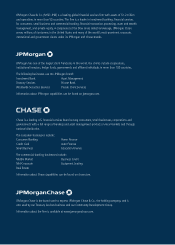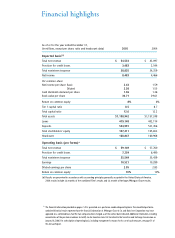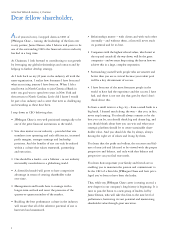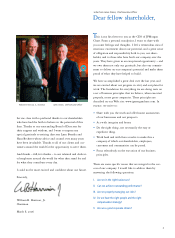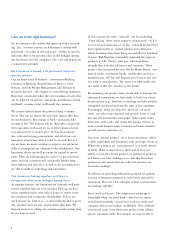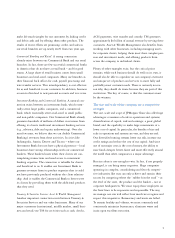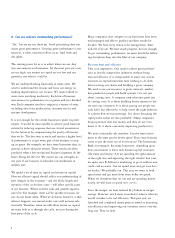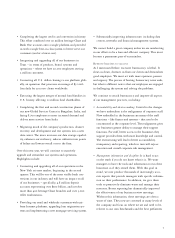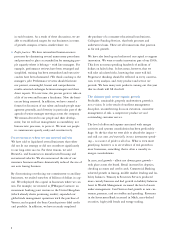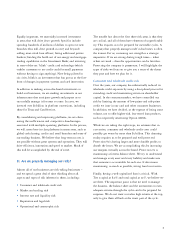JP Morgan Chase 2005 Annual Report Download - page 12
Download and view the complete annual report
Please find page 12 of the 2005 JP Morgan Chase annual report below. You can navigate through the pages in the report by either clicking on the pages listed below, or by using the keyword search tool below to find specific information within the annual report.
10
Market and trading risk, and interest rate and
liquidity risk
We need to manage our risk–return payoff better in .
In ,our trading volatilities were unacceptably high.
The $billion in trading revenues (not a bad result on its
own) was the result of two great quarters and two quarters
where we underperformed. We think that is too much
volatility, and reducing it is one of our priorities. I believe
we can accomplish this by continuing to diversify our trad-
ing business, by being more disciplined and precise in the
execution of our risk management practices, and by hiring
and retaining the best talent. We intend to deliver better,
more consistent results over time, while maintaining our
aggregate risk-taking appetite.
The good news is that we have aggressively invested to gener-
ate more diversified and consistent returns. For example, we
have added energy trading, and increased our activities in
mortgage- and asset-backed securities, and principal invest-
ing. Wehave leadership positions in credit markets and in
our derivatives franchises, and we will continue to invest in
order to sustain them. And while in the short run, some of
this has actually increased volatility,we are convinced that
our efforts – consistently applied – will succeed. However,
we caution our shareholders not to expect immediate results.
Interest rate exposure is another area in which financial
services companies can assume excess risk – often at great
peril. As with underwriting credit, good analysis of interest
rate exposure is rooted in facts and evaluations that are
based upon a variety of realistic assumptions and scenarios.
We devote substantial resources to understanding how
interest rate changes will affect our performance. This
analysis should be – and will be – an ongoing process. We
believe that our company has carefully managed its interest
rate risk so that even dramatic moves in rates of several per-
centage points cannot alone damage the company.
Ahealthy liquidity profile is essential to the ongoing via-
bility of any company, financial or otherwise. We use a vari-
ety of tools to maintain a strong liquidity position at the
parent and subsidiary companies, including stress scenarios,
collateral management and a conservative debt structure for
the company overall. We engage in a continual dialogue
with major rating agencies, and we are focused on main-
taining and improving our strong credit ratings.
Reputation and legal risk
The litigation costs in business are well known. We are
intensely focused on ways to safeguard the firm’s reputation
and exposure. They include:
•Senior management endorsement of a code of conduct
that all employees must sign and adhere to, as well as a
commitment to provide appropriate training.
•Astrong and independent compliance program that
encourages employees to assist in surfacing compliance
and ethical issues, and identifying money laundering and
terrorist financing activities.
•Amore robust due diligence process focused on securi-
ties underwriting transactions, where we have established
centralized oversight of our processes and standards.
•Adisciplined governance process to address conflicts and
review transactions that may present conflicts that could
harm the firm now or in the future.
•Aproductive and open dialogue with our regulators and
an ongoing emphasis on staying alert to changes in regu-
latory standards.
We believe that these actions will mitigate our exposure,
but we recognize, unfortunately, that they will not elimi-
nate it. We have also implemented a disciplined process to
continually review our liabilities and establish appropriate
litigation reserves. While we make every effort to properly
manage the company to reduce litigation and legal costs,
we believe that our shareholders should assume that high
legal costs will continue for the foreseeable future. They
should be viewed, unfortunately, as simply a higher, perma-
nent cost of doing business than in the past.
Operational and catastrophic risk
This year, we also made progress in strengthening our oper-
ational risk management programs. We have a consistent
approach across all businesses for defining and aggregating


